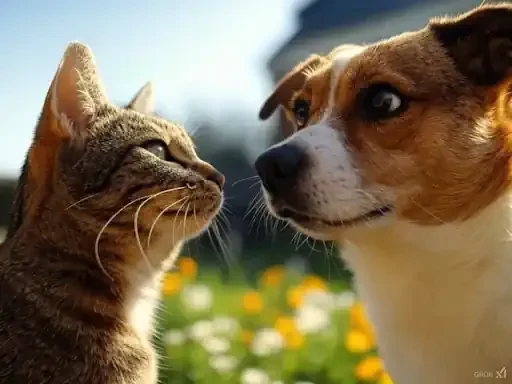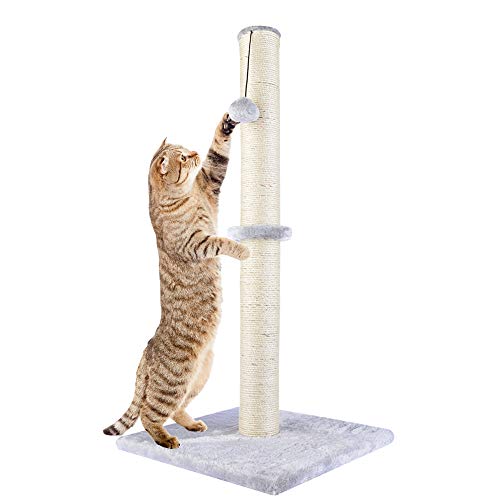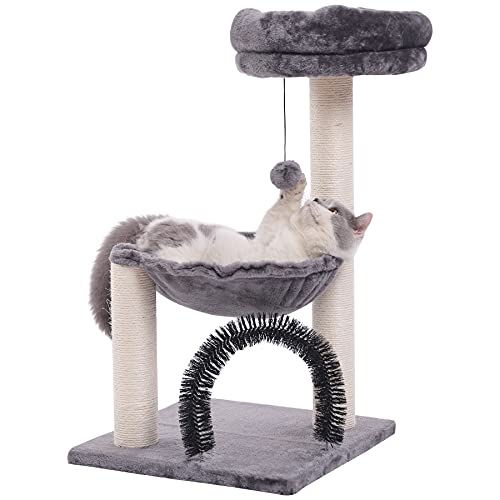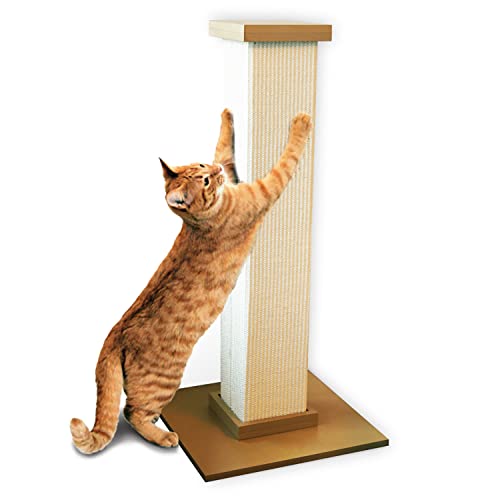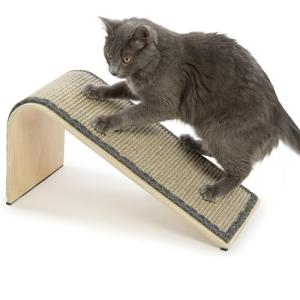It’s a scene as old as… well, as old as cartoons have been around to depict it. A yapping, boisterous canine relentlessly chasing a sleek, disdainful feline, sending furniture flying and fur bristling. The chase sequence, often played for comedic effect, is ingrained in our collective consciousness, a shorthand for conflict, chaos, and the inherent animosity that we’re led to believe exists between cats and dogs. From Tom and Jerry’s perpetual battles to countless tropes in popular culture, the notion of an unshakeable, almost primal feud between these two beloved domestic species is deeply embedded. We chuckle at the exaggerated skirmishes, nod knowingly at the stereotypes, and perhaps even recount anecdotes from our own lives or those of others, reinforcing the idea that cats and dogs are simply natural enemies. But is this really the truth? Is this ingrained narrative, this comfortable assumption of inherent conflict, actually reflecting the reality of the relationship between these two animals who share our homes and hearts? This article ventures to explore, analyze, and ultimately challenge this widely accepted narrative. While acknowledging that differences certainly exist between cats and dogs, we posit that the idea of a fundamental, ingrained feud is, to a significant extent, exaggerated and unfounded. We will delve into the origins of this persistent myth, examine the genuine behavioral disparities that might contribute to misunderstandings, and, crucially, shine a light on the overwhelming evidence that reveals the reality of coexistence, and even genuine affection, between cats and dogs. Through a comprehensive exploration, we aim to deconstruct the perceived "feud" and uncover the more nuanced, often harmonious, and ultimately, much more interesting truth about the dynamic between these two remarkable species.
The roots of the cat versus dog stereotype run deep, winding through the often murky waters of history, folklore, and cultural perceptions. To understand why this notion of inherent antagonism has taken such firm hold, we need to step back and consider how cats and dogs have been portrayed and perceived throughout human history. Did ancient cultures genuinely view them as natural adversaries, or is this a more modern construct? Examining ancient folklore and fables reveals a mixed bag, but often, the “enemy” narrative wasn’t as central as we might assume. While some narratives might pit animals against each other for symbolic purposes, the direct, species-specific animosity we see today isn't always prominent. Instead, folklore often used animals to represent human traits and conflicts, and any perceived antagonism might have been more about symbolizing broader societal tensions than a literal interpretation of animal behavior. Consider, for example, the independent nature of the cat, often linked to feminine mystique or even witchcraft in some historical periods, contrasted with the loyal, pack-oriented dog, often associated with masculinity and servitude. These symbolic associations, born from societal structures and gender roles, might have subtly contributed to the perception of inherent differences and, by extension, potential conflict, not necessarily stemming from the animals themselves, but projected onto them by human interpretations of their roles in our lives.
The real perpetuation of the "feud," however, likely found fertile ground in the rise of media and popular culture. Cartoons, with their reliance on visual shorthand and simplified narratives, became a powerful engine for cementing the cat-dog conflict into the popular imagination. Think of the iconic chases of Tom and Jerry, where slapstick violence and exaggerated conflict are the comedic core. The premise is simple: cat and mouse engage in constant, often destructive warfare. Extend this to the cat and dog dynamic, and the template is set. Characters like Itchy and Scratchy from The Simpsons, though satirizing Tom and Jerry, still rely on the same basic premise of exaggerated, species-based antagonism for humor. Movies, television shows, and even internet memes have continued to build upon this foundation, often utilizing the cat-dog conflict as a readily understood symbol for chaos, rivalry, or simply, comedic juxtaposition. News media, too, can inadvertently contribute to the exaggeration. Isolated incidents of conflict, while statistically rare, can be sensationalized and presented as evidence of a broader trend. A news story highlighting a dog attacking a cat, for instance, might gain more traction than a story about peaceful coexistence, simply because conflict is inherently more dramatic and newsworthy. This selective reporting, even unintentional, can contribute to a skewed perception of the actual frequency and nature of cat and dog interactions.
Beyond historical and media influences, we must also consider the deeply human tendency to anthropomorphize animals. We instinctively project our own emotions, motivations, and social frameworks onto the creatures around us, attempting to understand their behavior through a human lens. This anthropomorphic projection, while sometimes well-intentioned in fostering empathy, can also lead to oversimplified and often exaggerated interpretations of animal behavior. We might assume that a cat’s aloofness is deliberate disdain for a dog’s exuberance, or that a dog’s playful barking is intentionally aggressive towards a cat’s quiet demeanor. These are human interpretations imposed upon animal actions, often missing the nuances of their actual communication and motivations. Our own innate desire for clear-cut categories – friend versus foe, like versus dislike – further fuels this simplification. We are comfortable with binaries, and the idea of cats and dogs as inherently “opposed” neatly fits into this framework. It’s a clean, easily digestible narrative that requires less nuanced understanding and avoids the complexities of individual animal personalities and specific circumstances. Thus, the "feud" becomes not just a description of animal behavior, but a reflection of our own human need for order and easily categorized narratives.
Moving beyond the myth’s origins, it’s crucial to examine the actual behavioral differences between cats and dogs, because genuine disparities in communication and social styles do exist, and these can contribute to misunderstandings. These misunderstandings, however, should not be conflated with inherent animosity. Dogs, often described as social butterflies of the animal kingdom, are known for their direct and often exuberant communication style. Canine communication relies heavily on body language – the enthusiastic wagging tail, the inviting play bow, the direct gaze. Vocalizations, from playful barks to warning growls, are also prominent. Dogs operate within a social framework rooted in pack mentality, valuing clear social signals and direct interaction. Cats, on the other hand, are masters of subtlety. Feline communication is a delicate dance of nuanced body language – the twitch of an ear, the slow blink of an eye, the subtle shifts in tail posture. Scent marking through scratching and spraying plays a significant role, as does vocalization, although often in a less boisterous manner than dogs. Purrs, chirps, hisses – each carries a specific meaning, but often requires a more discerning eye to interpret compared to the more overt displays of canine communication. Cats are often characterized as more independent, their social structures less rigidly hierarchical than canine packs.
These contrasting styles are ripe for misinterpretation. A dog’s enthusiastic, direct approach, tail wagging and playful bow extended, might be perceived by a cat as overwhelming or even aggressive. The cat, preferring a more cautious and slow approach to interaction, might interpret the dog’s exuberance as a threat, leading to a defensive reaction – a hiss, a swat, a retreat. Conversely, a cat’s stillness, its deliberate slowness of movement and apparent aloofness, might be misinterpreted by a dog as disinterest or even a challenge. A dog, used to more overt social signaling, might perceive the cat’s calm observation as a lack of engagement, or, if the dog is less well-socialized, even as a signal of fear or weakness, triggering a predatory response. These are not signs of inherent hatred, but rather, classic examples of cross-cultural communication breakdown. Imagine two people from vastly different cultures trying to interact without a shared language or understanding of social cues. Misunderstandings are inevitable, but these misunderstandings do not equate to inherent dislike or animosity.
Another factor often cited in the supposed cat-dog feud is prey drive. It’s true that both dogs and cats retain predatory instincts, albeit to varying degrees and directed at different types of prey. Dogs, descended from pack hunters, often exhibit a chase and capture drive, sometimes triggered by smaller, rapidly moving animals. Cats, as solitary ambush predators, possess a highly refined hunting instinct directed at small rodents, birds, and insects. This inherent predatory drive can, in certain situations, lead to conflict between cats and dogs. A small dog, particularly certain terrier breeds with a high prey drive, might see a cat as something to chase. Similarly, a cat might be defensively aggressive towards a large dog it perceives as a threat. However, it’s crucial to emphasize that predatory drive doesn’t automatically translate to interspecies animosity. Predatory behavior is a complex instinct, often context-dependent and modifiable through socialization and training. Furthermore, predatory drive is not exclusive to cat-dog interactions. Dogs can chase squirrels, birds, or even bicycles, and cats can stalk and “hunt” anything from feather wands to dust bunnies. To frame predatory instinct as the primary driver of a supposed cat-dog feud is an oversimplification.
Territoriality and resource guarding are further common denominators, not species-specific animosities, that can contribute to conflict in multi-pet households. Both cats and dogs can be territorial, defending their perceived space and valued resources, which can include food, toys, sleeping areas, and even human attention. Conflict can arise over these shared resources, regardless of species. A cat might hiss at a dog approaching its food bowl, and a dog might growl at a cat attempting to take its favorite toy. These are not signs of interspecies hatred, but rather, typical displays of territoriality and resource guarding that can occur between any animals, even within the same species, sharing a space. Highlighting these behaviors as evidence of a cat-dog feud is again, a mischaracterization. Proper management, providing separate resources, and ensuring adequate space for each animal can significantly minimize these territorial disputes. The key takeaway is that while behavioral differences and inherent instincts like prey drive and territoriality do exist, these do not inherently condemn cats and dogs to a perpetual state of feud. These are manageable factors that can be addressed through understanding, socialization, and responsible pet ownership.
Against the backdrop of the perceived feud, the reality of everyday life for countless cats and dogs reveals a starkly different picture. Anecdotal evidence and observational studies paint a compelling portrait of peaceful coexistence, and even genuine friendship, flourishing between these two species within households across the globe. Countless homes are testaments to interspecies harmony, where cats and dogs not only tolerate each other, but actively seek each other’s company, engage in playful interactions, and exhibit signs of genuine affection. Think of the heartwarming images and videos that populate the internet – dogs and cats curled up asleep together, grooming each other, playfully batting at each other's tails, or simply existing in comfortable, shared spaces. These are not isolated incidents; they represent a pervasive reality in multi-pet homes where species lines blur and genuine companionship blossoms. Observational studies, while perhaps less prevalent than anecdotal accounts, further support this reality. Surveys of multi-pet households consistently reveal that peaceful coexistence is far more common than intense conflict. While occasional squabbles might occur, particularly during initial introductions or over resources, sustained, aggressive feuds are relatively rare in well-managed environments. These studies, often involving owner questionnaires and direct observation of animal interactions, point to a general trend of tolerance and even positive relationships between cats and dogs living together.
The power of socialization, particularly during early developmental stages, is a critical factor in shaping interspecies interactions. Just as puppies and kittens learn to navigate their own species’ social cues during their formative weeks, they can also learn to accept and even bond with individuals of other species, if introduced appropriately during this crucial window. Kittens and puppies raised together from a young age are significantly more likely to develop strong bonds. Early exposure during this period allows them to learn each other’s communication styles, establish shared social norms within the household, and overcome any innate predispositions towards interspecies aversion. They grow up viewing each other not as "cat" or "dog," but simply as members of their social group, their "family." Even introducing adult cats and dogs, while potentially requiring more patience and careful management, is often successful. With slow, controlled introductions, allowing each animal to acclimate to the other's scent and presence before direct interaction, and providing safe spaces for retreat, adult animals can learn to coexist peacefully and, in many cases, even develop positive relationships. The key is a gradual, non-threatening introduction process that respects each animal's individual personality and comfort level.
Beyond simply tolerating each other, cats and dogs in harmonious households can often exhibit cooperative behaviors and experience mutual benefits from their interspecies companionship. Observing cats and dogs playing together, for example, reveals a fascinating adaptation of play styles. They often modify their typical play behaviors to accommodate the other species, engaging in games that bridge the gap between canine and feline play preferences. A dog might tone down its boisterous chasing, while a cat might become more tolerant of a dog’s more direct approach. This cooperative play demonstrates a level of interspecies understanding and adaptation that goes far beyond mere tolerance. Furthermore, cats and dogs can provide each other with valuable social enrichment. In multi-pet households, they can serve as playmates, offering companionship and reducing boredom, especially when human owners are away. They can also provide each other with a sense of security, acting as a form of mutual "alarm system," alerting each other to potential threats or changes in the environment. Some anecdotal accounts even describe cats and dogs engaging in mutual grooming behaviors, licking and cleaning each other, further blurring species lines and showcasing genuine interspecies bonding. These cooperative and mutually beneficial interactions highlight the significant potential for positive relationships between cats and dogs, relationships that far transcend the simplistic narrative of inherent feud.
Ultimately, the dynamic between cats and dogs in a shared home is profoundly shaped by human influence. Owners play a pivotal role in fostering harmony, or inadvertently contributing to discord, depending on their approach and understanding of interspecies dynamics. Responsible pet ownership is paramount in creating a peaceful multi-species environment. This starts with careful and well-planned introductions, particularly when bringing a new cat or dog into an existing multi-pet household. Rushing introductions, forcing interaction before animals are comfortable, or failing to provide separate safe spaces can create unnecessary stress and increase the likelihood of conflict. Slow, gradual integration, allowing animals to acclimate to each other's scent and presence through scent swapping and visual separation initially, is crucial for setting a positive foundation. Providing separate resources is another key element of responsible ownership. Ensuring that each cat and dog has its own food bowls, water bowls, sleeping areas, and preferred toys minimizes competition and resource guarding issues. Creating vertical space for cats, allowing them to retreat to elevated perches away from dog interactions if they desire, is particularly important for feline comfort and security.
Understanding and respecting individual personalities is equally vital. Just as humans have diverse personalities, so too do cats and dogs. Some cats are naturally more tolerant and social, while others are more reserved. Similarly, some dogs have a higher prey drive or are less well-socialized than others. Owners need to observe and respond to the individual needs and temperaments of each animal, adjusting their management strategies accordingly. For example, a more sensitive cat might require more gradual introductions and more readily available safe spaces than a bolder cat. Managing prey drive and territoriality through training and environmental design is also crucial. Training dogs to respond to commands like "leave it" or "stay" can help mitigate chasing behaviors. Providing puzzle feeders and engaging in structured playtime can help redirect predatory instincts into appropriate outlets. Environmental modifications, such as ensuring secure fencing in yards to prevent outdoor chases or using baby gates to create separate zones within the house, can also play a significant role in minimizing potential conflicts.
Conversely, misguided human expectations and interventions can actually contribute to tension in a multi-pet household. Human anxieties and preconceived notions about the "feud" can inadvertently create a self-fulfilling prophecy. If owners are constantly anticipating conflict, nervously monitoring interactions, and projecting their own anxieties onto the animals, they can create a tense atmosphere that actually increases the likelihood of stress and reactivity. Interfering too much in natural animal interactions, particularly playful interactions that might involve some chasing or wrestling, can also be counterproductive. As long as the interactions are playful and not escalating into genuine aggression, allowing animals to establish their own boundaries and social dynamics is often the best approach. Projecting human interpretations onto animal behavior and reacting based on these interpretations can also be detrimental. For example, scolding a dog for barking at a cat might be misinterpreted by the dog as punishment for simply reacting to a novel stimulus, potentially increasing anxiety and reactivity in the long run. Finally, inadvertently encouraging rivalry by favoring one species over the other can create resentment and tension. Ensuring that attention, affection, and resources are distributed fairly and equitably amongst all pets in the household is crucial for maintaining harmony.
In conclusion, the persistent narrative of a deep-seated feud between cats and dogs, while entertaining in cartoons and ingrained in popular culture, is, upon closer examination, largely a myth. While genuine behavioral differences and inherent instincts might sometimes contribute to misunderstandings, these factors are far from insurmountable and certainly do not condemn these two species to a perpetual state of war. The “feud,” in reality, is an exaggeration, a simplification, and often, a mischaracterization of a dynamic that is far more nuanced and often, surprisingly harmonious. The origins of this myth are rooted in historical and cultural portrayals, amplified by media portrayals and reinforced by our human tendency to anthropomorphize animal behavior. However, understanding the contrasting communication styles of cats and dogs, while acknowledging the existence of instincts like prey drive and territoriality, reveals that these are manageable factors, not insurmountable barriers to coexistence. The overwhelming evidence from anecdotal accounts and observational studies, coupled with the undeniable power of socialization and responsible pet ownership, showcases the true reality: cats and dogs can, and often do, live peacefully, and even happily, together. Owners play a crucial role in shaping this dynamic, with responsible management, understanding individual animal needs, and challenging preconceived notions being key to fostering interspecies harmony. It’s time to challenge the ingrained stereotype, to move beyond the simplistic narrative of inherent feud, and to embrace a more nuanced and realistic perspective on cat-dog relationships. Cats and dogs are not destined to be enemies. They are, in fact, capable of coexistence, companionship, and even genuine affection. Perhaps, by reframing the narrative and embracing the reality of interspecies harmony, we can not only enrich the lives of our animal companions but also gain a deeper understanding of the complexities and beauty of animal behavior, moving towards a world where cat and dog harmony is seen not as an exception, but as the norm.
